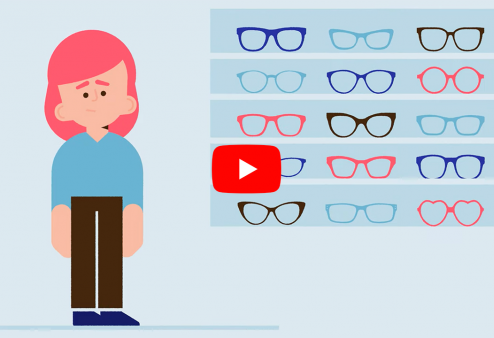The prescription your optometrist writes for your eyeglasses might be confusing, but it tells you a lot about your vision. Here's how to make sense of the symbols you see.
You’ve probably never really looked at this piece of paper before. It’s got a bunch of numbers, abbreviations, and scribbles on it. It’s your eyeglass prescription, and it can literally help you see the world in a whole new way.
Here’s a breakdown of your prescription, including what all those confusing terms mean.
Has it been a while since your last eye exam? Now’s the time to book an appointment!
OD, OS, and OU
See the letters OD and OS? They’re Latin terms for your right eye and left eye. If you see OU on the prescription, that refers to both of your eyes.
SPH (Sphere)
Now take a look at SPH, which stands for sphere. The numbers in this column tell you how well you see objects up close and far away in each eye. The minus sign represents nearsightedness, and the plus sign means farsightedness. Here’s an example: if you see the number –2.00 after OD in the SPH column, it means your prescription calls for two diopters, a unit we use to measure lens power to correct the nearsightedness in your right eye. Two diopters means you’re only mildly nearsighted. The higher that number, the more nearsighted you are and the stronger your prescription will be.
CYL (Cylinder)
Next up is CYL, which stands for cylinder. This tells you if you have astigmatism which means things may look blurry because your eye isn’t totally round. If you don’t see a number here, you don’t have astigmatism. But if you do, the number represents how much lens power is needed to correct it.
Axis
Axis follows cylinder. This term refers to the direction of the astigmatism on your eye. The axis, which ranges from 1 to 180, tells you if your astigmatism is straight up and down 90 degrees, across your cornea 180, or somewhere in between.
Prism
You may see the word “Prism” but very few prescriptions include it. This is typically used to fix rare issues with eye alignment.
ADD Power
Then there’s ADD Power, which means you need more magnifying power in the lower part of a bifocal lens to see better up close. Add power becomes a factor in your 40s when you start to have trouble focusing on close-up tasks, like reading. It’s due to a condition called presbyopia, and it’s a normal part of aging. Last we checked, 1.8 billion people have presbyopia, which literally means old eye. It’s nothing a prescription tweak can’t help correct.
Additional Information
The last thing to check out is the additional information section where your eye doctor can recommend things like eyeglass brands, lens coatings, or lens materials.
Expiration Date
Finally, pay close attention to the expiration date on your eyeglass prescription. An eyeglass prescription typically expires after one to two years. That’s because your eyes change enough in that period to need a new prescription.
Make sure you regularly see your eye doctor to keep your eyes in shape, and we can help.
Recommended Reading



